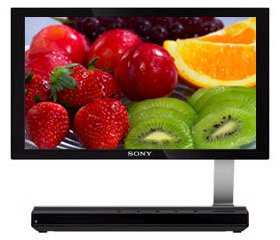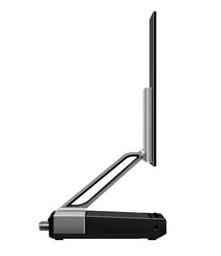
 |
| Home >
TV Displays > OLED TV |
|
OLED TV DISPLAYS Organic Light Emitting Diode TV • How to hook up a Plasma or LCD HDTV • How to hook up a Cable TV box • Cable TV - Cable Box Setup • Cable TV - Cable Box Setup Scientific Atlanta 4250HDC • Surround Sound over HDMI • Surround Sound - How to Hookup • HDTV Buying Guide 2010 • HDTV Antennas |

 |
Oct. 1, 2007 - Sony introduced the world's first OLED TV. At 3 millimeters thin, Sony?s XEL-1 OLED TV has an almost paper-thin display, hovers mounted on a beam, which is juxtaposed onto a thick pedestal base, which sharply contrasts the screens thickness. The 11-inch XEL-1 brings a lot of innovation to the table at a relatively high price. The XEL-1 OLED TV's razor thin profile can be seen viewing the side profile. The XEL-1 is an 11 inch display that is only 3mm thin. The measurements of the XEL-1 are 287?253?140mm. Sony has put the ultra-thin display on a pedestal with a flexible arm. The OLED TV (XEL-1), which weighs two kilograms and is about 3mm thin, features a resolution of 940?540 and contrast ratio of 1,000,000:1. The first Sony OLED TV takes input resolution up to 1080p. Sony plans to start shipping the XEL-1 OLED TV on December 1, 2007 in Japan for 200,000 Yen (~$1,740). This is a very high price for an 11 inch TV, but it is the first OLED TV to buy. Early adoption always has its price. The XEL-1 also boasts superior color and brightness. The brightness is due to the OLEDs' natural electroluminescence as well as reflected light, which reflects off of "micro-cavities" within the OLED. The end result is a much brighter TV without the need for backlights. The color is also superior and more natural. With flexible brightness, it is easier to reproduce the full spectrum of colors than in a device which can only be backlit or dark. The XEL-1 has a declared 30,000 hour lifespan (roughly the equivalent of watching TV eight hours a day for ten years). An average LCD lifespan is 50,000 hours, so while slightly lower, the XEL-1 isn't that far behind. The device features some nice extras in terms of ports as well. It has an integrated digital TV tuner for Japan, USB, LAN interface, one HDMI port, headphones plug and S-Force sound. Despite its attractive features, Sony plans to limit its initial production to 2,000 units a month. In contrast, its LCD TV business sells over 10 million TVs a year. Given that Sony is heralding the XEL-1 as the start of a new sector of its TV business, it is safe to say its OLED displays will soon be coming to the U.S. Samsung has produced a prototype 40 inch OLED TV but it is not ready for mass production yet. LG has announced a 15 inch OLED TV said to be ready for 2010 production. LG's new TV harnesses the organic process of electrophosphorescence to produce video. The screen uses an active matrix of organic light emitting diodes (AM-OLED), which are self-illuminating and therefore need no backlighting. OLED screens are thinner and use less power than the more widely used liquid crystal displays (LCDs), which require backlighting. The picture quality from OLED technology is superior to LCDs or plasma, since it is brighter and has greater contrast and better refresh rates. Because OLED screens are so thin, they can be made flexible. They also have a wide viewing angle. OLED is the fourth major type of flat screen technology to be developed, and joins LCD, plasma and SED (surface-conduction electron emitter display). The first OLED television, the 11-inch XEL-1, was launched in 2007 by Sony Corporation, but this has not been followed by new models. It has been the only OLED TV available commercially from 2007 through 2009. OLED technology has been used in some of the higher-end cellular phones, but it is much more expensive than LCD technology, and this has so far severely limited its use in mass-produced items such as televisions and personal computers. Sony's XEL-1 retails for around $2,500 in the U.S. , but LG's TV is expected to retail for much less. LG Electronics plans to make its OLED television available for commercial sale in South Korea first and in 2010, worldwide. LG is also planning to launch a 40-inch OLED television "in the not too distant future." By 2013 production of OLED TVs is predicted to reach 2 million units. |
|
How to Hook Up a Plasma TV Connect Plasma TV |
|
OLED TV expected to eventually replace Plasma and LCD TV So long LCD, goodbye Plasma, there's a new TV in town. Razor thin displays using less power than LCD TVs and producing bright colors. OLED offers displays which are thinner than current LCD or plasma HDTVs, and because the polymer films which make up the OLED are very flexible as well as thin, they don't need a rigid substrate as do these other technologies. This means that OLED screens could be rolled-up like a newspaper. OLEDs are also brighter than LCD because they are emissive devices not merely transmissive. LCD has to pass light produced by a backlight and in so doing, it naturally absorbs and attenuates some of it. Also because OLEDs do not function by blocking light but rather by producing it, they don't have the problems with off-axis viewing that LCD possesses. What is OLED? Organic light emitting diode (OLED) technology uses substances that emit red, green, blue or white light. Without any other source of illumination, OLED materials present bright, clear video and images that are easy to see at almost any angle. OLED displays stack up several thin layers of materials. They operate on the attraction between positively and negatively charged particles. When voltage is applied, one layer becomes negatively charged relative to another transparent layer. As energy passes from the negatively charged (cathode) layer to the other (anode) layer, it stimulates organic material between the two, which emits light visible through an outermost layer. Doping or enhancing organic material helps control the brightness and color of light. And manufacturers can choose organic materials? structure ? ?small? (single) molecules or complex chains of molecules (polymers) ? to best suit production facilities. Active matrix and passive matrix screens are two fundamental types of OLED display assembly. The first OLEDs were developed by Kodak in the late 1980s and since then, companies such as Samsung and Sony have been working to perfect both the technology itself and its manufacturability. Light sources based on organic electroluminiscent materials offer the potential to make a high light intensity possible at a low energy consumption on mechanically flexible substrates. TV WALLPAPER is coming. Just a millimeter thick - will transform your whole living room wall into a flat screen as thin as a sheet of paper and will serve as your display screen for the internet, the news, images or games. Soon, all of this will be possible thanks to organic light-emitting diodes. The organic process used in OLED is called electrophosphorescence and is a biological phenomenon. Fireflies, plankton, and many sea creatures all possess this characteristic naturally. But it's only in the last few years that researchers have been able to synthesize it non-biologically. Even though these OLED panels are made up of several layers of doped fluorocarbon polymers, the result is a system which is very thin, usually less than 0.5 thousandths of a millimeter thick. These OLEDs produce self-luminous displays that do not require backlighting (as LCD does) and can operate at very low current with only 2-10 volts. These thin displays can be made flexible, and have a wide viewing angle of up to 170 degrees. OLED TV The primary benefit of OLED displays over traditional LCDs is that OLEDs do not require a backlight to function, and consume less power during operation. OLED displays are expected to be more efficiently manufactured than LCDs and plasma displays. The Active Matrix OLED technology has layers of cathode, organic molecules and anode, the anode layer overlays a thin film transistor (TFT) array that forms a matrix. The TFT array itself is the circuitry that determines which pixels get turned on to form a picture. The fledgling technology of making ultra-thin displays using organic light-emitting diodes (OLED) is starting to bear fruit finally with Sony, Samsung SDI and other makers introducing new applications. Sony is selling an 11-inch OLED TV for the first time in the world in late 2007. Korean firms such as Samsung Electronics, Samsung SDI, LG Electronics, LG.Philips LCD and Neoview Kolon are also investing in the technology, which should replace the current LCD and plasma panels in the long term, becoming the norm for digital displays. OLED panels use certain organic compounds that emit red, green and blue light in response to electric signals. Unlike LCD, OLED panels do not need an additional light source, or "backlight,'' so they are slimmer and more energy-efficient, and capable of showing clearer, fast-responding images. How are OLED TVs made? The biggest part of manufacturing OLEDs is applying the organic layers to the substrate. Organic vapor phase deposition (OVPD) - In a low-pressure, hot-walled reactor chamber, a carrier gas transports evaporated organic molecules onto cooled substrates, where they condense into thin films. Using a carrier gas increases the efficiency and reduces the cost of making OLEDs. OVPD is an innovative technology for the thin film deposition of small molecular organic materials. It utilizes the advantages of gas phase deposition, where the materials are transported to the substrate by an inert carrier gas. Inkjet printing - With inkjet technology, OLEDs are sprayed onto substrates just like inks are sprayed onto paper during printing. Inkjet technology greatly reduces the cost of OLED manufacturing and allows OLEDs to be printed onto very large films for large displays like 80-inch TV screens or electronic billboards. • Plasma, LCD, OLED HDTV Displays Cable Types and connections For a hookup diagram see: HDTV basic setup See over 100 Hookup Diagrams See also: • PC stereo hookup • Windows Sound Recorder • VCR Recording • How to wall mount Plasma or LCD HDTV • Audio Video Connections • See over 100 hook up diagrams • Surround Sound formats explained • How to buy loudspeakers • HDTV Hookup Diagrams • TV input select • Timer Record Radio Shows on a VCR • TV too loud? • FM transmitter for TV sound • Camcorder hookup to TV, DVD • Camcorder Buying Guide • Audio Video Connections • Hookup Diagrams |